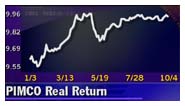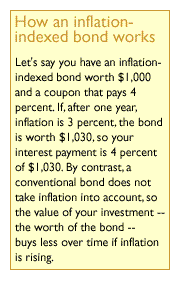|
Mutual Fund Notebook
|
 |
October 5, 2000: 2:17 p.m. ET
PIMCO bond fund; Answers to your fund questions; Health fund winners
By Staff Writer Martine Costello
|
NEW YORK (CNNfn) - Inflation may be bad for your wallet, but PIMCO bond fund manager John Brynjolfsson says inflation-indexed bonds can provide a safety net for your long-term portfolio.
Brynjolfsson, of PIMCO Real Return Bond Fund, says bonds that rise and fall with the rate of inflation can ensure that your retirement dollars keep up with the cost of living.
 "If you were to invest in the fund and come back 10 years later, what you'd find is performance mirrored your needs - so if the cost of retiring was higher than expected because of higher inflation, the fund's performance would mirror that." "If you were to invest in the fund and come back 10 years later, what you'd find is performance mirrored your needs - so if the cost of retiring was higher than expected because of higher inflation, the fund's performance would mirror that."
Inflation-indexed bond funds, also known as Treasury Inflation-Indexed Securities, or TIPS, are pegged to the Consumer Price Index, the main barometer of inflation in the U.S. economy.
Also in this column: CNNfn.com will start answering a question every week from readers about mutual funds; New winners on the performance charts; and more about CNNfn.com's revamped Mutual Fund Notebook.
"It doesn't create a home run when inflation goes up, and it doesn't create a crater when inflation goes down," Brynjolfsson said. "What it does is keep the bonds' earning stream in line with the underlying real economy."
 The Real Return fund, with $398 million in assets, is up 10.05 percent year to date as of Sept. 30. It is part of the same family of funds headed by Bill Gross, considered by many to be the best bond fund manager on Wall Street. The Real Return fund, with $398 million in assets, is up 10.05 percent year to date as of Sept. 30. It is part of the same family of funds headed by Bill Gross, considered by many to be the best bond fund manager on Wall Street.
Gross's PIMCO Total Return Bond Fund has about 7 percent of its portfolio in inflation-indexed bonds and is up 6.7 percent year to date as of Sept. 30.
Inflation first started rising in late 1998, and continued moving up in 1999, sending inflation-indexed securities much higher.
The Federal Reserve on Tuesday held rates steady, but indicated inflation is still a risk.
Brynjolfsson said rising inflation was not the primary reason for the strong returns this year.
He attributed the fund's success in 2000 to capital gains associated with falling "real" yields (the rate of return after deducting the inflation rate from the interest rate) as fears subsided about Year 2000 glitches and the market absorbed an excess supply of 10-year TIPS.
Rising energy prices and a slight uptick in the core inflation rate also contributed to demand for TIPS, he said.
Brynjolfsson thinks the Fed will hold off on raising rates for the rest of the year, and may even cut rates in 2001. But he thinks the fund will do well regardless of whether inflation rises or falls.
The PIMCO fund is different from its peers because it also can invest in corporate inflation-indexed bonds, floating-rate corporate bonds, bonds that are below investment grade, and international bonds, if they are hedged against local currency to reduce risk, he said.
The important message for investors is that TIPS can "break the mold," of the old saying that you can't get good returns without taking risks, Brynjolfsson said.
"For those who don't watch screens minute to minute and economic releases second to second, TIPS make a lot of sense because they are suited toward the long-term needs of investors," Brynjolfsson said. "TIPS are as close to a risk-free security as I can fathom because they are government-guaranteed and they are indexed to the biggest financial risk we all face, which is inflation."
Question of the week: Load fund fees
Load mutual fund fees can tricky to figure out. One reader wrote CNNfn.com recently with a question about the effect of putting front-end load funds in a Roth IRA.
Question: My wife and I both make monthly contributions into Roth IRAs, investing in no load mutual funds. However, the returns and ratings on some load funds are so attractive that we are considering investing a portion of our contributions in them. Our question is this: do the fees that we will pay for the front end load count against our $2,000 annual limit on IRA contributions?
Peter Di Teresa, who writes the "Ask the Professor" personal finance column for Morningstar, said load fees are like brokers' commission - so they are not deductible from your $2,000 limit.
Front-end loads are a one-time fee that you pay when you buy a fund through a broker. The average fee is around 5.75 percent, Di Teresa said.
Let's say you buy $2,000 in shares of a fund with a 5 percent front-end load. That's a fee of $100, he said.
But if you buy a good fund with low annual fees, the front-end load won't matter years from now.
"Even if it has a load, you'll still get good long-term returns," Di Teresa said. One good load fund family he recommends is American Funds, which have very low annual fees.
Winners in mutual funds
Health-care funds continue to dominate the charts this year.
Out of the top 10 U.S. stock funds tracked by Morningstar, seven are health funds. At the top of the list is Evergreen Health Care Fund, up 110.76 percent year to date as of Oct. 4. Next is Nicholas-Applegate Global Health Fund, up 109.96 percent in the same time.
The three non-health funds in the top ten are Schroder Micro Cap Fund, a small blend fund up 109.85 percent; American Eagle Capital, a large growth fund, up 101 percent; and PIMCO Global Innovation, a tech fund, up 100.80 percent.
CNNfn.com has revamped its weekly Mutual Fund Notebook. This column will run under the headline "Mutual Fund Notebook" and appear on Thursdays. It will include interviews with managers, help with portfolio issues and weekly winners and losers. You can e-mail the retirement planning staff your mutual fund questions to retirement@cnnfn.com.
* Disclaimer 
-- Click here to send e-mail to Staff Writer Martine Costello.
|
|
|
|
|
 |

|

